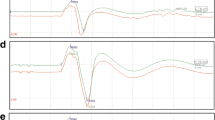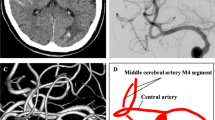Summary
Neurophysiological examinations of brainstem functions before, during and after selective interventional neuroradiology i.e. selective intra-arterial thrombolytic therapy of an acute occlusion of the basilar artery are reported. The success of the therapy was demonstrated by the reappearance of normal somatosensory potentials and of the blink reflex immediately after the thrombolysis. The BAEPs were continuously recorded during the thrombolysis. Normalization of the latencies and of the interpeak latencies at a very early stage of the therapy indicated the improvement of brainstem functions.
Zusammenfassung
Neurophysiologische Untersuchungs- und Über-wachungsmethoden der Hirnstammfunktionen vor, während und nach selektiver Katheterangiographie i.V., selektive intraarterielle Thrombolyse-therapie eines akuten Arteria basilaris-Verschlusses werden dargestellt. Der Erfolg der Therapie wurde anhand des Wiederauftretens normaler somato-sensorischer Potentiale und aller Blinkreflex-Komponenten unmittelbar nach der Thrombolyse demonstriert. Die akustischen Hirnstammpotentiale wurden kontinuierlich während der Therapie überwacht: In einem sehr frühen Stadium der Thrombolyse zeigt die Normalisierung der Latenzzeiten und der Transmissionszeit die Erholung der Hirnstammfunktion an.
Similar content being viewed by others
References
Archer C, Horenstein S (1972) Basilar artery occlusion: clinical and radiological correlation. Stroke 8:383
Dengler R, Struppler A (1981) Beurteilung der Lokalisation und Ausdehnung von Hirnstammaffektionen mit Hilfe des Orbicularis oculi-Reflexes. Z EEG-EMG 12:50
Dorndorf W, Gänshirt H (1972) Die Klinik der arteriellen zerebralen Verschlüsse. In: Gänshirt H (Hrsg) Der Hirnkreislauf. Thieme, Stuttgart
Fesefeldt C, Hacke W, Zeumer H (1981) Veränderungen des Blinkreflexes bei computer-tomographisch faßbaren morphologischen Läsionen des Hirnstamm. Z EEG-EMG 12:226
Giblin DR (1980) Scalp-recorded somatosensory evoked potential. In: Aminoff MI (ed) Electrodiagnosis in clinical neurology. Churchill Livingstone, NewYork Edinburgh London
Grundy B (1980) Evoked potential monitoring during neurosurgical operations. Am Soc of Anesthesiology St. Louis (Postersession)
Hacke W, Zeumer H, Berg-Dammer E (1983) The monitoring of hemispheric or brainstem functions with neurophysiological methods (SEP, BAEP, EEG analysis) during interventional neuroradiology. AJNR (in press)
Hashimoto I, Ishiyama Y, Totsuka G, Mitzutani H (1980) Monitoring brainstem function during posterior fossa surgery with brainstem auditory evoked potentials. In: Barber C (ed) Evoked potentials. it Press, Lancaster
Kimura J, Lyon LW (1972) Orbicularis oculi reflex in the Wallenberg syndrome: alteration of the late reflex by lesions of the spinal tract and the nucleus of the trigeminal nerve. J Neurol Neurosurg Psychiatr 35:228–255
Noel P, Desmedt JE (1975) Somatosensory cerebral evoked potentials after vascular lesions of the brainstem and diencephalon. Brain 98:113–128
Oh SJ, Kuba T, Soyer A, Choi JS, Banikowski EP, Vitek J (1981) Lateralization of brain-stem lesions by brainstem auditory evoked potentials. Neurology 31:14–18
Ongerboor de Visser BW, Kuypers HGJM (1976) Late blink reflex changes in lateral meduallary lesions.An electrophysiological and neuroanatomical study of Wallenberg's syndrome. Brain 101:285–294
Rowe MJ (1981) The brainstem auditory evoked response in neurological disease: A review. Ear Hearing 2:41–51
Starr A, Hamilton AE (1976) Correlation between confirmed sites of neurological lesions and abnormalities of Far-Field auditory brainstem responses. Electroencephalogr Clin Neurophysiol 41:595–608
Starr A, Nudleman K, Allen A (1983) Assessment of sensory function in the operating room utilizing cerebral evoked potentials: A study of fifty-six patients. Clin Neurosurg (in press)
Stockard JJ, Stockard JE, Sharbrough HF (1980) Brainstem auditory evoked potentials in neurology: Methodology, interpretation, clinical application. In: Aminoff MJ (ed) Electrodiagnosis in clinical neurology. Churchill Livingstone, NewYork Edinburgh London
Stockard JJ, Stockard JE, Sharbrough HF (1978) Nonpathological factors influencing brain-stem auditory potentials. Am J EEG Technol 18:177–209
Thompson JR, Simons CR, Hasse AN, Hinshaw DB (1978) Occlusion of the intradural vertebro-basilar artery. Neuroradiology 14:219
Zeumer H, Hacke W, Kolmann HL, Poeck K (1982) Lokale Fibronolysetherapie bei Basilaris-thrombose. Dtsch Med Wochenschr 19:728–731
Author information
Authors and Affiliations
Rights and permissions
About this article
Cite this article
Hacke, W., Berg-Dammer, E. & Zeumer, H. Evoked potential monitoring during acute occlusion of the basilar artery and selective local thrombolytic therapy. Arch Psychiatr Nervenkr 232, 541–548 (1982). https://doi.org/10.1007/BF00344069
Received:
Issue Date:
DOI: https://doi.org/10.1007/BF00344069




